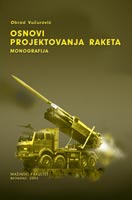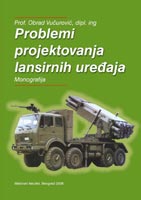|
|

This book (465 p.) has everything one needs
to know about ballistic and free rockets
science, design, construction, build, technology
and test.
ABSTRACT:
The book contains four parts considering
whole rocket development process - design,
constructing and testing, including assembly line
production.
First part considers efficiency and
efficiency criteria, target properties, firing
errors, target hit and destruction probability.
Second part includes rocket movement, it's dynamic characteristics with
displayed and solved differential equations.
Rocket forces and moments with random values identifying and their
mathematical interpretation.
Planar and space rocket movement and trajectory influented by
environment, particularly by wind.
Rocket flight stability and guidance with random disturbances and fly
control system for Ground-To- Ground rockets.
Third part contains missile dispersion theory, particularly for rockets.
Disturbing forces and dominant influences causing rocket dispersion,
including their preventing or reducing processes, are shown and determined.
All mentioned above provide rocket project requirements and constructive
solutions.
Part four encircles rocket construction problems, starting with material
choice, further detailly construction development, important values
optimization, solutions mutual dependencies, reproductivity, all-phases quality
control, production conditions, etc.
Rocket air-brakes unfolding through launcher mechanism, thus reducing
rocket dispersion
are presented.
Warheads are fully attended, including ones' different types and the
newest solutions.
All these processes are followed by different
testing methods from the very beginning to the end of assembly line
production, especially in anticipated extreme conditions of use.
Testing optimization during development process and production
maintaining level of quality criteria and costs reduction of testing optimization
are presented, too.
Separate chapter is given to rocket reliability and cost.
Rocket development trends and their usage rentability compared to
missiles, are given in the end.
This book is intended for students and engineers engaged in rocket
armament R&D.
KEYWORDS:
Rocket, unguided rocket, missile, rocket design, rocket construction, rocket
guidance, rocket control, rocket testing, rocket reliability, rocket cost, target
destruction, target hit probability, firing errors, rocket movement, rocket
forces and moments, rocket flight stability, rocket dispersion, fin-stabilized
rockets, gyro-stabilised rockets, anti-armour rockets dispersion, wind
influence on rocket flight. |
|
|
|
|
|
|
|

This book (503 p.) provides complete
science projects, modern engineering and
technology of launchers design.
ABSTRACT:
All development aspects of launcher, often
neglected rocket system component, are
considered, in this five-part book
First part considers all launcher main
parameters, particularly system efficency and
procedures determining one.
Second part contains basic forces utilizing
launching theory, particularly at launcher firing, as well as dynamic loadings,
including random forces influences.
Launcher disturbance and random forces equations are also presented.
Several different solutions of existing launchers are analyzed and presented.
Special attention is given to Multiple Launching Rocket System
strengthness and stability, i.e. system orientation maintaining of firing
parameters in purpose of minimization of launcher disturbance during every
successive firing sequence.
MLR System oscillation given case study as particularly important in
purpose of launcher disturbance angle and angular velocity minimizing.
Third part includes methods of basic launcher project parameters
defining. This is the most important part of project, because errors made
in this part of project have fundamental influence in following work
generating problems difficult to be solved.
Launcher influence on rocket leaving velocity increasing as much as
possible. New solutions resolving this problem are given.
Rocket movement in launcher are shown in a certain number of variants
with respectively consideration of good and bad properties.
There are given procedures of launcher tubes number determination,
rocket parameters during leaving tube, rocket rotation inside launching tube,
opened or closed launching tube, tube mechanisms, etc.
Elevation and direction launcher tubes movement, as well as launcher
leveling – automatic, semiautomatic and manual, are detailly given. Importance
and procedures of selfbreaking and breaking of launcher mechanisms are emphasized.
The book also presents fire correction data subsystem based on TV
corrector recordings the end of rocket motor burning.
Automatic and semiautomatic launcher loading solutions are given.
Design solutions of mechanisms enabling firing from unprepared launching
positions are given.
All operations automatization procedures are given, in purpose of human
operator role minimizing.
On-launcher fire control system, devices and procedures that enable to
command post both ways connection and automatic command transfer, are
given.
For ground troops vehicle mounted launchers, consequent performances
and adaptations of vehicles are presented.
Basic performances for underground, submarine and airborne launchers
are given, too.
Part four presents launcher construction solutions according to different
factors: materials, parts and structures design, tolerances, material surface
protection, technological procedures, etc, emphasizing standardization and
unification.
As very important launcher construction part, there are given tests during
launcher development and production phases according to all expected
conditions of use in different environment.
In the end of part four are given chapters about reliability and cost in
different launcher design and manufactoring phases.
Part five contains overview presentations of strategic launchers of all
types.
Different terrain properties where launcher can be positioned are given in
appendix.
This book is intended for students and engineers engaged in rocket
armament R&D.
KEYWORDS:
Launcher, launching device, launching, rocket start, launcher efficiency,
forces on launcher-rocket system, launcher dynamics, launcher design
methods, start from fixed launcher, 3D launch start case, random launcher
disturbances, main launcher parameters, launching device construction, gas-
generated auxilliary thrust in launcher, launching tube, launcher control
subsystems, launcher automatics, launchers fire control system, launcher
carriers, launcher design, launcher testing, launcher reliability, launcher cost,
strategic and tactical launchers, terrain characteristics. |
|
|
|
|
|
|
